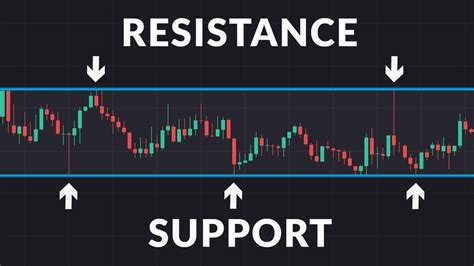Introduction
In the dynamic world of financial trading, understanding support and resistance levels is crucial for successful decision-making. These levels represent pivotal points in an asset’s price action, influencing its future trajectory. This guide will delve into the intricacies of support and resistance trading, providing comprehensive knowledge to navigate market fluctuations effectively.

What is Support and Resistance?
Support is a price level below which an asset’s price has difficulty falling. It acts as a floor, preventing the price from declining further. Conversely, resistance is a price level above which an asset’s price encounters resistance, limiting its upward movement and often causing a reversal.
Identifying Support and Resistance Levels
1. Historical Price Action:
Analyzing historical price charts is a primary method for identifying support and resistance levels. Look for areas where the price has consistently bounced off or reversed direction.
2. Moving Averages:
Moving averages (MAs) smooth out price fluctuations, revealing underlying trends. They can act as support or resistance when the price approaches or crosses the MA line.
Trading Strategies
1. Support Trading:
- When the price falls below a support level, it creates a potential buying opportunity.
- Traders anticipate that the price will bounce off the support and rally higher.
- Stop-loss orders should be placed below the support level to manage risk.
2. Resistance Trading:
- When the price rises above a resistance level, it indicates a potential selling opportunity.
- Traders expect the price to encounter resistance and reverse lower.
- Stop-loss orders should be placed above the resistance level to protect profits.
Breakouts and False Breakouts
1. Breakouts:
When the price breaks through a support or resistance level with significant momentum, it signals a potential change in trend.
2. False Breakouts:
Not all breakouts are genuine. Sometimes, the price may break through a level but quickly reverse back within it, known as a false breakout.
Common Mistakes to Avoid
1. Premature Trading:
Trading too early before a clear break of support or resistance can lead to false signals and losses.
2. Ignoring Risk:
Not setting appropriate止损 orders leaves traders exposed to excessive losses in case of unfavorable price movements.
3. Overtrading:
Trading too frequently without thorough analysis can increase the risk of making emotional decisions.
Market Insights
According to a study by Investopedia, over 90% of successful traders rely on support and resistance analysis in their trading decisions.
Another study by TradingView reveals that support and resistance levels are more effective in trending markets than range-bound markets.
Pros and Cons
Pros:
- Provides clear entry and exit points for trades
- Helps manage risk effectively
- Improves trading discipline and profitability
Cons:
- Not always reliable, especially in volatile markets
- Can lead to false signals if not interpreted correctly
- Requires experience and practice to master
Conclusion
Support and resistance trading is a powerful tool that empowers traders to capitalize on market opportunities and minimize losses. By understanding the concepts, identifying levels effectively, and employing appropriate strategies, traders can increase their trading success in the ever-evolving financial landscape.
Additional Resources
- Support and Resistance Explained in 5 Minutes
- Trading with Support and Resistance – 10 Tips
- The Ultimate Guide to Support and Resistance Trading
Tables
Table 1: Historical Price Action – Identifying Support and Resistance
| Date | Price | Action |
|---|---|---|
| 2023-01-01 | 100 | Bounced off support |
| 2023-03-01 | 120 | Reversed at resistance |
| 2023-05-01 | 110 | Declined below support |
| 2023-07-01 | 130 | Broke through resistance |
Table 2: Support and Resistance Trading Strategies
| Strategy | Entry Point | Exit Point |
|---|---|---|
| Support Trading | Price falls below support | Rally above support |
| Resistance Trading | Price rises above resistance | Decline below resistance |
Table 3: Common Mistakes to Avoid in Support and Resistance Trading
| Mistake | Description |
|---|---|
| Premature Trading | Trading before a clear break of support/resistance |
| Ignoring Risk | Neglecting stop-loss orders |
| Overtrading | Trading too frequently without analysis |
Table 4: Pros and Cons of Support and Resistance Trading
| Pros | Cons |
|---|---|
| Clear entry and exit points | Not always reliable in volatile markets |
| Enhanced risk management | False signals if not interpreted correctly |
| Improved trading discipline | Requires experience and practice |



